 W
WThe city now known as Mexico City was founded as Mexico Tenochtitlan in 1324 and a century later became the dominant city-state of the Aztec Triple Alliance, formed in 1430 and composed of Tenochtitlan, Texcoco, and Tlacopan. At its height, Tenochtitlan had enormous temples and palaces, a huge ceremonial center, residences of political, religious, military, and merchants. Its population was estimated at least 100,000 and perhaps as high as 200,000 in 1519 when the Spaniards first saw it.
 W
WThe 1985 Mexico City earthquake struck in the early morning of 19 September at 07:17:50 (CST) with a moment magnitude of 8.0 and a maximal Mercalli intensity of IX (Violent). The event caused serious damage to the Greater Mexico City area and the deaths of at least 5,000 people. The sequence of events included a foreshock of magnitude 5.2 that occurred the prior May, the main shock on 19 September, and two large aftershocks. The first of these occurred on 20 September with a magnitude of 7.5 and the second occurred seven months later on 30 April 1986 with a magnitude of 7.0. They were located off the coast along the Middle America Trench, more than 350 kilometres (220 mi) away, but the city suffered major damage due to its large magnitude and the ancient lake bed that Mexico City sits on. The event caused between three and four billion USD in damage as 412 buildings collapsed and another 3,124 were seriously damaged in the city.
 W
WAlameda Central is a public urban park in downtown Mexico City. Created in 1592, the Alameda Central is the oldest public park in the Americas. It is located in Cuauhtémoc borough, adjacent to the Palacio de Bellas Artes, between Juárez Avenue and Hidalgo Avenue. Alameda Central can be accessed by Metro Bellas Artes.
 W
WThe Battle of Churubusco took place on August 20, 1847, while Santa Anna's army was in retreat from the Battle of Contreras or Battle of Padierna during the Mexican–American War. It was the battle where the San Patricio Battalion, made up largely of American deserters, made their last stand against U.S. forces. The U.S. Army was victorious, outnumbering more than two-to-one the defending Mexican troops. After the battle, the U.S. Army was only 5 miles (8 km) away from Mexico City. About 50 of the captured San Patricios were later hanged.
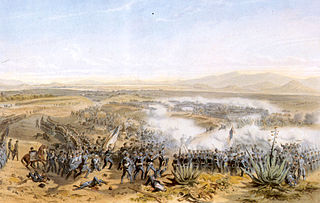 W
WThe Battle of Contreras, also known as the Battle of Padierna, took place on 19–20 August 1847, in one of the final encounters of the Mexican–American War, as invading U.S. forces under Winfield Scott approached the Mexican capital. American forces surprised and then routed the Mexican forces General Gabriel Valencia, who had disobeyed General Antonio López de Santa Anna's orders for his forces' placement. Although the battle was an overwhelming victory for U.S. forces, there are few depictions of it in contemporary popular prints. The armies re-engaged the next day in the Battle of Churubusco.
 W
WThe Battle of Molino del Rey was one of the bloodiest engagements of the Mexican–American War as part of the Battle for Mexico City. It was fought in September 1847 between Mexican forces under General Antonio León against an American force under Major General Winfield Scott at El Molino del Rey on the fringes of Mexico City. The Americans made little progress in this battle, but the Mexican forces were unable to hold them back long enough to prevent the capture of Mexico City one week later.
 W
WRicardo Bell was the artistic name of Richard Bell Guest an English clown and entrepreneur, famous in Mexico in the late 19th and early 20th centuries. After he became famous as the main actor of Circo Orrín, one of the famous circuses of Mexico City and by becoming the most successful clown in the country, Bell founded his own Gran Circo Ricardo Bell. The poet Juan de Dios Peza wrote in El Monitor Republicano newspaper about Bell that he "is more popular than pulque", in an epoch were the pulque was the preferred alcoholic beverage in Mexico.
 W
WThe Casa de los Azulejos or "House of Tiles" is an 18th-century Baroque palace in Mexico City, built by the Count of the Valle de Orizaba family. The building is distinguished by its facade, which is covered on three sides by blue and white tile of Puebla state. The palace remained in private hands until near the end of the 19th century. It changed hands several times before being bought by the Sanborns brothers who expanded their soda fountain/drugstore business into one of the best-recognized restaurant chains in Mexico. The house today serves as their flagship restaurant.
 W
WThe 2017 Puebla earthquake struck at 13:14 CDT on 19 September 2017 with an estimated magnitude of Mw7.1 and strong shaking for about 20 seconds. Its epicenter was about 55 km (34 mi) south of the city of Puebla. The earthquake caused damage in the Mexican states of Puebla and Morelos and in the Greater Mexico City area, including the collapse of more than 40 buildings. 370 people were killed by the earthquake and related building collapses, including 228 in Mexico City, and more than 6,000 were injured.
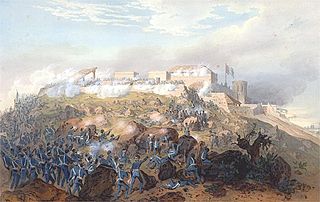 W
WThe Battle of Chapultepec on 13 September 1847 was an assault by invading American forces on a small contingent of Mexican forces holding the strategically located Chapultepec Castle just outside Mexico City. The building, sitting atop a 200-ft (60-m) hill, was an important position for the defense of the city. For the campaign to take Mexico City, of which the Battle of Chapultepec is a part, General Winfield Scott's U.S. Army totaled 7,200 men. General Antonio López de Santa Anna deployed Mexican forces to several sites to defend the capital, so just 880 troops, including military cadets of the Military Academy defended the position at Chapultepec against 2,000 U.S. forces. The Mexican forces' loss opened the way to take the center of Mexico City. In Mexican history, the battle is cast as the story of the brave deaths of six cadets, the Niños Héroes, who leapt to their deaths rather than be taken captive, with one wrapping himself in the Mexican flag. The U.S. has many depictions of the battle from their point of view. Although it lasted only about 60–90 minutes, the battle has great importance in the histories of both countries.
 W
WCuicuilco is an important archaeological site located on the southern shore of Lake Texcoco in the southeastern Valley of Mexico, in what is today the borough of Tlalpan in Mexico City. The settlement goes back to 1400 BC.
 W
WThe Franz Mayer Museum, in Mexico City opened in 1986 to house, display and maintain Latin America’s largest collection of decorative arts. The collection was amassed by stockbroker and financial professional Franz Mayer, who collected fine artworks, books, furniture, ceramics, textiles and many other types of decorative items over fifty years of his life. A large portion comes from Europe and Asia but most comes from Mexico itself with items dating from the 15th to the 20th centuries. Many pieces in the collection are fine handcrafts, such as textiles and Talavera pottery, and they are important because they are items that often did not survive because most did not consider them worth preserving.
 W
WThis article covers the history of the Colonia Roma neighborhood of Mexico City.
 W
WThe History of Mexico mural in the stairwell of the National Palace in Mexico City was executed between 1929 and 1935 by Diego Rivera. The subject of the mural is Mexico's history from ancient times to the present. They depict the many struggles of the common Mexican people to fight against the Spanish, the French, and the dictators that controlled the country at different points in its history.
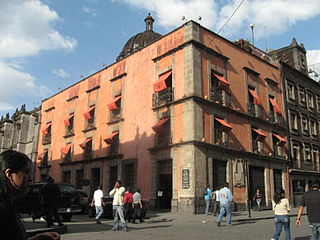 W
WThe House of the First Printing Press in the Americas at the corner of Moneda and Licenciado Primo Verdad streets in Mexico City was the home of the first printing press/print shop in the New World. The printer Juan Pablos oversaw the printing of at least 35 books at this print shop between 1539, the date of the first book printed in the Americas, and his death in 1560.
 W
WMexico City has a community of Japanese Mexican people and Japanese expatriates that is dispersed throughout the city. Many Japanese persons had moved to Mexico City in the 1940s due to wartime demands made by the Mexican government. Multiple Japanese-Mexican associations, the Japanese embassy, the Liceo Mexicano Japonés, and other educational institutions serve the community. The residents are educated through the LMJ, the part-time school Chuo Gakuen, and the adult school Instituto Cultural Mexicano-Japonés.
 W
WThis is a list of the preserved Colonial churches in Mexico City, the capital of Mexico.
 W
WThis is a list of the preserved Pre-Columbian-era archaeological sites in Mexico City, the capital of Mexico.
 W
WThe Battle for Mexico City refers to the series of engagements from September 8 to September 15, 1847, in the general vicinity of Mexico City during the Mexican–American War. Included are major actions at the battles of Molino del Rey and Chapultepec, culminating with the fall of Mexico City. The U.S. Army under Winfield Scott scored a major success that ended the war.
 W
WThe Battle for Mexico City refers to the series of engagements from September 8 to September 15, 1847, in the general vicinity of Mexico City during the Mexican–American War. Included are major actions at the battles of Molino del Rey and Chapultepec, culminating with the fall of Mexico City. The U.S. Army under Winfield Scott scored a major success that ended the war.
 W
WThe Metropolitan Cathedral of the Assumption of the Most Blessed Virgin Mary into Heaven is the seat of the Catholic Archdiocese of Mexico. It is situated atop the former Aztec sacred precinct near the Templo Mayor on the northern side of the Plaza de la Constitución (Zócalo) in Downtown Mexico City. The cathedral was built in sections from 1573 to 1813 around the original church that was constructed soon after the Spanish conquest of Tenochtitlan, eventually replacing it entirely. Spanish architect Claudio de Arciniega planned the construction, drawing inspiration from Gothic cathedrals in Spain.
 W
WOn 4 November 2008 an official Mexican Secretariat of the Interior aircraft crashed in central Mexico City at around 18:45 local time. There were sixteen fatalities—all nine people on board and seven people on the ground died. The plane was carrying Mexican Secretary of the Interior Juan Camilo Mouriño.
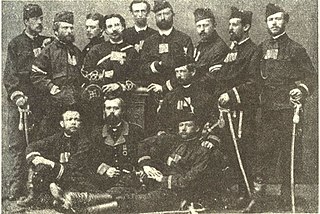 W
WThe Siege of Mexico City was an 1867 military engagement in the Second French intervention in Mexico between Mexican Republican forces, aided by the United States, and Emperor Maximilian's troops, aided by the French Empire and Austria-Hungary, encompassing in the siege of the city. It was the last armed conflict of the Second Mexican Empire and the fall of the city resulted in the transition of the Empire into the Republic led by Benito Juárez.
 W
WThe Museo de la Secretaría de Hacienda y Crédito Público is an art museum located in the historic center of Mexico City. It is housed in what was the Palacio del Arzobispado, built in 1530 under Friar Juan de Zumárraga on the base of the destroyed pyramid dedicated to the Aztec god Tezcatlipoca. It remained the archbishphoric until 1867 when the Finance Ministry Accountancy Department was established there. The modern museum houses an exhibit dedicated to this god as well as a large art collection.
 W
WThe Museo Nacional de las Culturas is a national museum in Mexico City dedicated to education about the world's cultures, both past and present. It is housed in a colonial-era building that used to be the mint for making coins. Prior to this, the site was the home of the location of the Moctezuma's Black House. The mint was moved to Apartado Street in 1850, and the building was used for various purposes until it was converted to its current use in 1966.
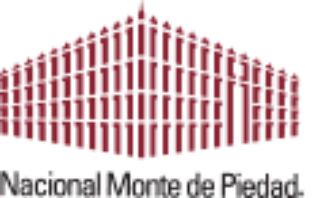 W
WThe Nacional Monte de Piedad is a not-for-profit institution and pawnshop whose main office is located just off the Zócalo, or main plaza of Mexico City. It was established between 1774 and 1777 by Don Pedro Romero de Terreros, the Count of Regla as part of a movement to provide interest-free or low-interest loans to the poor. It was recognized as a national charity in 1927 by the Mexican government. In the first decade of the 21st century, it is a fast-growing institution, with over 200 branches all over Mexico and plans to open a branch in every Mexican city.
 W
WThe National Palace is the seat of the federal executive in Mexico. It is located on Mexico City's main square, the Plaza de la Constitución. This site has been a palace for the ruling class of Mexico since the Aztec Empire, and much of the current palace's building materials are from the original one that belonged to the 16th century leader Moctezuma II.
 W
WThe Palace of Iturbide is a large palatial residence located in the historic center of Mexico City at Madero Street #17. It was built by the Count of San Mateo Valparaíso as a wedding gift for his daughter. It gained the name “Palace of Iturbide” because Agustín de Iturbide lived there and accepted the crown of the First Mexican Empire at the palace after independence from Spain. Today, the restored building houses the Fomento Cultural Banamex; it has been renamed the Palacio de Cultura Banamex.
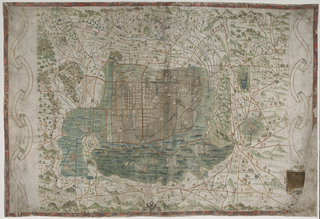 W
WThe Santa Cruz Map is the earliest known city map of Mexico City as the capital of New Spain. The map depicts the city’s layout with its buildings, streets, and waterways surrounded by the lakes of the basin of the Valley of Mexico and the countryside beyond. In the map one can also see images of daily life, animals and plants. It is a watercolor map that was painted between 1550 and 1556.
 W
WTenochtitlan, also known as Mexico-Tenochtitlan, was a large Mexica altepetl in what is now the historic center of Mexico City. The exact date of the founding of the city is unclear. The date 13 March 1325 was chosen in 1925 to celebrate the 600th anniversary of the city. The city was built on an island in what was then Lake Texcoco in the Valley of Mexico. The city was the capital of the expanding Aztec Empire in the 15th century until it was captured by the Spanish in 1521.
 W
WFollowing a summer of increasingly large demonstrations protesting the 1968 Olympics held in Mexico City, the Mexican Armed Forces opened fire on 2 October 1968 on unarmed civilians, killing an undetermined number, in the hundreds. It occurred in the Plaza de las Tres Culturas in the Tlatelolco section of Mexico City. The events are considered part of the Mexican Dirty War, when the US-backed PRI regime violently repressed political and social opposition. The massacre occurred 10 days before the Olympics' opening ceremony.
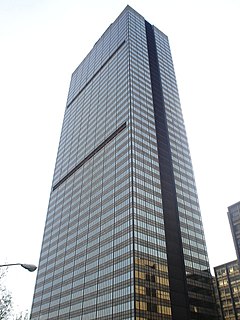 W
WOn 31 January 2013 in Mexico City, an explosion caused by a gas leak occurred beneath Building B-2 at the Torre Ejecutiva Pemex, a skyscraper complex that is the headquarters of Pemex, the Mexican state oil company. At least 37 people died and another 126 were injured when an explosion occurred in a building adjacent to the main tower. Earlier in the day, Pemex sent out a tweet saying that the building was being evacuated due to a "problem with the electrical system" in the complex that includes the skyscraper.
 W
WThe Torre Latinoamericana is a skyscraper in downtown Mexico City, situated in the historic city center. Its central location, height, and history make it one of the city's most important landmarks. It is widely recognized internationally as an engineering and architectural landmark since it was the world's first major skyscraper successfully built on highly active seismic zone. The skyscraper notably withstood the 8.1 magnitude 1985 Mexico City earthquake without damage, whereas several other structures in the downtown area were damaged.
 W
WXochimilco is one of the 16 mayoralities or boroughs within Mexico City. The borough is centered on the formerly independent city of Xochimilco, which was established on what was the southern shore of Lake Xochimilco in the precolonial period. Today, the borough consists of the eighteen “barrios”, or neighborhoods, of this city along with fourteen “pueblos”, or villages, that surround it, covering an area of 125 km2 (48 sq mi). The borough is in the southeastern part of the city and has an identity that is separate from the historic center of Mexico City, due to its historic separation from that city during most of its history. Xochimilco is best known for its canals, which are left from what was an extensive lake and canal system that connected most of the settlements of the Valley of Mexico. These canals, along with artificial islands called chinampas, attract tourists and other city residents to ride on colorful gondola-like boats called “trajineras” around the 170 km (110 mi) of canals. This canal and chinampa system, as a vestige of the area's precolonial past, has made Xochimilco a World Heritage Site. In 1950, Paramahansa Yogananda, in his Autobiography of a Yogi, wrote that if there were a scenic beauty contest, Xochimilco would get the first prize. However, the impacts of colonization as well as severe environmental degradation of the canals and chinampas have brought that status into question.
 W
WThe Zócalo or Plaza del Zócalo is the common name of the main square in central Mexico City. Prior to the colonial period, it was the main ceremonial center in the Aztec city of Tenochtitlan. The plaza used to be known simply as the "Main Square" or "Arms Square", and today its formal name is Plaza de la Constitución. This name does not come from any of the Mexican constitutions that have governed the country but rather from the Cádiz Constitution, which was signed in Spain in the year 1812. Even so, it is almost always called the Zócalo today. Plans were made to erect a column as a monument to Independence, but only the base, or zócalo, was built. The plinth was buried long ago, but the name has lived on. Many other Mexican towns and cities, such as Oaxaca, Mérida, and Guadalajara, have adopted the word zócalo to refer to their main plazas, but not all.